How to Lower Your Commercial Insurance Premiums
How to Lower Your Commercial Insurance Premiums Out of the various overheads businesses face, the most important one that helps safeguard most of the risks is commercial insurance. These include damage to property, liabilities of any sort, injuries to employees, and much more. Providing security that covers your assets and makes you eligible to meet business obligations if something untoward happens, this insurance becomes a heavy burden on the balance sheet. One good thing is that you don’t have to drop your commercial insurance coverage so that you can reduce your commercial insurance premiums. With a few strategies, you can lower costs without forsaking protection. Let’s discuss the best practices to lower commercial insurance costs without lowering their quality in this book. Periodical Review and Update of Coverage One of the most straightforward ways to cut down on commercial insurance cost would involve reviewing policies from time to time. Businesses evolve and grow over the years to become wholesome or are forced to downsize or alter the shape that their activities take, which greatly impacts the coverage required. You end up over-insuring some aspects of the business when downsizing or bringing in fewer employees. You save money by not paying for coverage that no longer applies over your business as you realign your insurance coverage with the immediate needs of your business. Action Steps Annual review of your insurance Examine how you are changing your business operations with your agent or broker -Eliminate riders or coverage you don’t need from the policy. Group coverage with the same insurance company One way in which some insurers might save you money is by bundling together different kinds of coverage within a single policy. The most common use of bundling is to combine general liability with either property or workers’ compensation. Bundling tends to make policy management easier and could quite often lead to some savings because most insurers want to be loyal to their customers; they wish to encourage them to become multi-policy customers and offer them some sort of discount on their premiums. Actions Talk about your bundled policies with your agent in insurance Compare a bundle offer to an individual policy to identify savings Bundle policies should be sufficient enough for the coverage of your business Finally, Raise Your Deductible Deductible refers to the amount that one needs to pay before making a claim. In general terms, the higher is the deductible level on the policy then more the insurance premium. The higher your deductible is going to be, the more you are going to pay for each and every future claim. That will make the company expose itself towards lesser risks and force them to lower down your monthly or annual premium. But it’s a good thing to remember that you have money set aside to pay for the extra cost of the deductible if and when it is time to submit a claim. Being able to afford a higher deductible is not in your best interest if you do not have money in savings available to you at the time you will be submitting your claim to pay for the extra cost. Action Take a look at what your current deductible is. Compare how much in premium savings you’d receive with higher deductible options. You should have an emergency fund in case you need to claim in future due to deductibles. Carry Out Risk Management and Safety Measures You would want to consider the fact that sometimes, insurance premiums are a function of how risk-prone your business seems to the insurers. The lesser you do in reduction of risk, the lesser the likely, your insurer is going to reward with lower premiums. For example, safety nets will minimize your chances of having accident, theft or even damage; therefore it will significantly minimize your cost on insurance. This would ensure organizations with employees have a much safer working environment. This way, even conditions of working injuries can be worked upon to being totally eradicated; such incidents influence the comp premium risk of the workers. Installation of security systems, fire suppression systems, and cybersecurity measures reduce your overall profile for risk. Steps to Action -Risk Assessment and Safety Measures End Install Security Systems (alarms, cameras, etc.) and Fire Suppression Systems Train your staff on the issue of safety from time to time Invest in cybersecurity especially when your business has sensitive information to handle Improve Your Business Credit Rating Business How much will it cost: You will pay less on your commercial insurance premiums if you have a good credit rating score for business. The underwriter identifies businesses with a bright credit rating as risk-free because most such businesses will be paying premiums in time, and running them will be stable as well. What does it all amount to? If your business has a low credit rating score, you will have to dig deeper into your pocket and pay more on the premiums. Care for the bills and responsible interaction with the debt. The debt will improve your business credit score, and you’ll probably attract a better insurer that would reduce the premiums that you might face. Action steps: Business Credit Score Bill payments and premiums Pay off the debt as much as possible Low levels of credit utilization Shop Around for Quote Premiums and discounts differ from one insurance company to another. Advise that one goes around the companies to search for quotes then compare the quotes. Sometime following the price prices charged by others may save you much money. Price war is no option with faithful clients sometimes you must change a provider since you feel that another will sell you at better value. Review coverage from a “best value based on dollar coverage” standpoint rather than trying to find the least expensive. You want low-cost premiums, but you also want assurance coverage exists for your business. Action items Get quotes from three different insurance providers and


